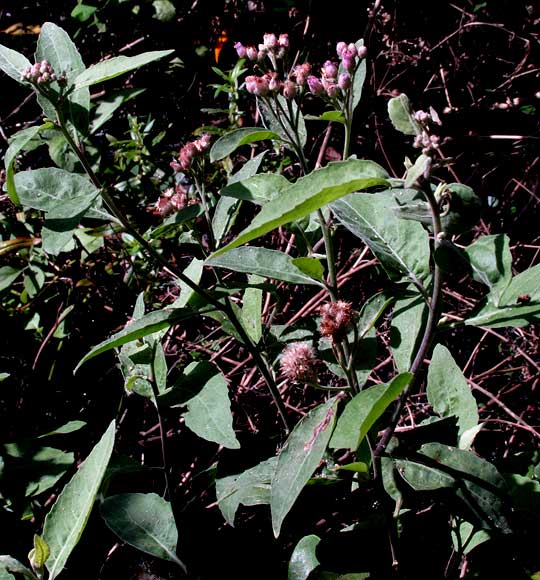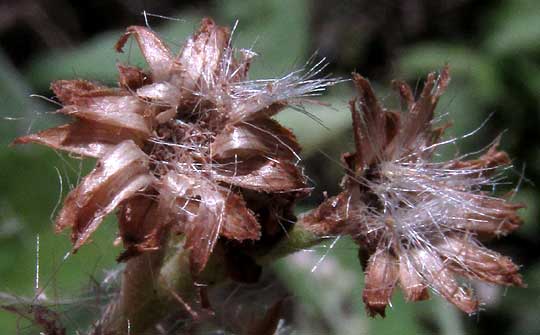Excerpts from Jim Conrad's
Naturalist Newsletter
from the February 15, 2015 Newsletter issued from Río Lagartos, on the Yucatan Peninsula's northern coast (~N21.60°, ~W88.16°), Yucatán state, MÉXICO
SALT-MARSH FLEABANE
There's a certain group of fair-sized, herbaceous members of the Composite or Sunflower Family whose curiously thick, urn-shaped heads lack petal-like ray flowers, and whose leaves always emit a powerfully musky-sweet odor when crushed, known by such names as camphorweed, stinkweed, sourbushes -- names referring to the leaves' pungent odor. They're members of the genus Pluchea, and over the years I've profiled several of them, usually in dry, often weedy habitats. Nowadays around here a certain Pluchea is loaded with pea-sized, purplish flowering heads, and the curious thing about the plants is that mainly they grow next to water that's often brackish or salty. Below, you can see part of such a plant next to a little pond:

A close-up of some flowering heads is shown below:

The plant's odor and the flowering heads' distinctive shape are so diagnostic for the genus Pluchea that this is one instance when it's not necessary to look at tiny details of individual florets and achenes to figure out the plant's identity. One nice feature about it is worth showing, however, and that's how the bracts forming the urn-shaped involucre holding the individual disc flowers, once the fruits are released into the wind, turn brown and curve backwards, forming interesting little brown "flowers," as shown below:

The genus Pluchea embraces 40-60 species of tropical and warm-temperate plants throughout most of the world, but only four Pluchea species are listed for the Yucatan. Our plant with its soft-hairy stems and leaves, entire leaf margin (lacking teeth or lobes), and preference for wet soil reveals itself as PLUCHEA ODORATA, and goes by such English names as Salt-marsh Fleabane, Sweetscent and Shrubby Camphorweed. It's native to coastal habitats and inland wetlands from the US south to northern South America, including the Caribbean, and it also turns up in western Africa and on certain Pacific Islands.
With such a strong odor you might guess that traditionally it's been used medicinally. In Mexico it's even honored with the appellation Santa MarÃÂa, a name applied to several unrelated but powerfully smelling herbs thought to be blessedly medicinal. Mainly it's used as a vaginal wash for various female problems, and for washing up after childbirth. Leaves and stems can be brewed with cinnamon sticks for a tea that alleviates menstrual problems. Teas also are used for upset stomachs, "rheumatism," fevers, to speed up deliveries during childbirth, and even for female sterility. Other uses include being taking for headaches, inflamed gums, lung ailments, earaches, and to cure such psychic or occult problems as "espanto," or fear, and "mal aire," which literally means bad air, when it's understood that witchery causes the air to be bad.
Moreover, a 2011 paper by S Bauer and others found that extracts of Salt-marsh Fleabane "disturb cancer cell cycle progression," thus warrant further study in the fight against cancer. A 2012 paper by M. Seelinger and others found support for the belief that extracts of the plant speed up healing and might hinder tumor formation.